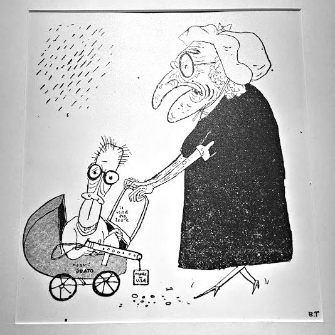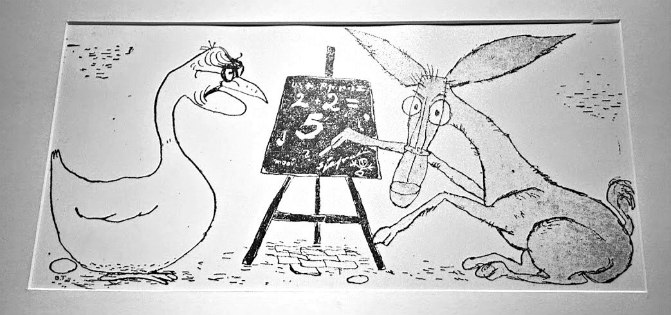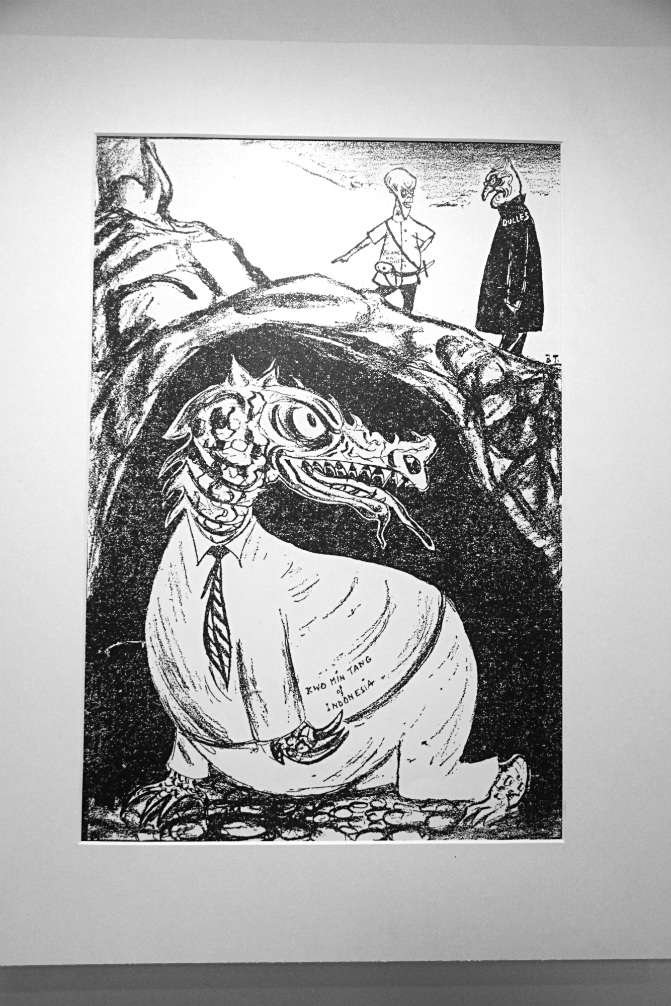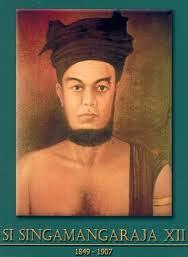A fearsome stork carrying South Korea’s first president, a scowling cornerman injecting Egypt’s Gamal Nasser with “Anti-Communist Serum,” an elderly nanny pushing a gun-toting Syafruddin Prawiranegara in a stroller – Cold War-era diplomat John Foster Dulles is variously depicted as each of these in old cartoons by Augustin Sibarani, recently put on display for the first time at the National Library in Jakarta.
The exhibit ends today, but you can see many of the best pieces from the show right here.
Sibarani, an Indonesian caricaturist who is a favorite of the celebrated scholar Benedict Anderson, drew for leftist newspaper Bintang Timur in the 1950s and 60s, right up until founding President Sukarno was ousted and replaced by General Suharto.
Sibarani’s eldest son, Sanggam Sibarani, was on a mission to tell his father’s spellbinding life story – he is planning several books – when he stumbled upon a treasure trove of the elder Sibarani’s Bintang Timur work in the National Library’s archives. One thing led to another, and soon his lost works were on display at the National Library exhibition.


John Foster Dulles the nanny strolls Syafruddin Prawiranegara, a baby equipped with a US-made machine gun; A photo of Dulles (you can see Sibarani really captures the beadiness of his eyes)

Dulles props up Egypt’s Gamal Nasser against Abd al-Karim Qasim, the Iraqi leader who didn’t want to ally with Nasser and Syria’s United Arab Republic
Dulles, the US secretary of state under President Dwight Eisenhower who advocated an aggressive stance against communism throughout the world, was one of Sibarani’s favorite whipping boys. Whether Sibarani represents him as a giant rat preparing to feast on a fish resembling Sumatra, a Christmas tree at Eisenhower’s party or a doofy farm animal, the artist always distinguishes Dulles’ likeness with round-framed glasses, an unpleasant frown and a comically hooked nose. The American is often shown with Prawiranegara, who spearheaded the US-backed PRRI rebellion against Sukarno’s government in 1958.

A fish resembling Sumatra is fried for Dulles by Syafruddin and Sumitro Djojohadikoesoemo

Dulles and Syafruddin learn simple arithmetic

Little boy Dulles’ PRRI kite, whose face resembles Syafruddin, is ensnared in the ‘rakyat’ (people) tree.
From freedom fighter to state illustrator
Born in 1925 in North Sumatra, Sibarani grew up in a wealthy Batak family and studied Dutch in school. Two decades later, during Indonesia’s independence war, he was stabbed in the chest – by a soldier from his own side. According to Sanggam, his father had been tasked with investigating corruption in the ranks, but the project rubbed some the wrong way.
A week later, the colonialists took over Salatiga, Central Java, where Sibarani was hospitalized. Dutch troops entered the room in which the wounded man lay bedridden.
A nurse stepped between them. “If you want to kill him, you have to kill me,” she said.
“He’s dying anyway,” a doctor said to further dissuade the men. “Don’t waste your bullets.”
The ploy worked, but Sibarani knew the Dutch could return at any time. That same day he slipped out of the hospital and into the forest. Dutch forces gave chase, Sanggam said, but Sibarani found a graveyard and concealed himself in an empty plot. Soon he reached an Indonesian army post on the slopes of Mount Merbabu outside Yogyakarta.

A chess game

Chinese leader Chiang Kai-Shek uses Dulles’ nose as a weapon
After the war, Sibarani left the military to dedicate himself to art. His skills attracted the attention of Sukarno, and the president included him in cultural delegations and enlisted him in government projects.
When Sukarno needed a picture of the late Batak holy man Sisingamangaraja XII for his national heroes program, he dispatched Sibarani to North Sumatra to recreate the visage of the man of whom no photograph existed. There Sibarani played the police sketch artist, tracking down Sisingamangaraja’s children and associates and illustrating him from their memories.
Blacklisted and pirated
Then, suddenly, everything changed. From 1965, Suharto consummated his coup de grace with a mass-killing campaign that took the lives of, at least, hundreds of thousands of alleged communists. Many more were sent to prison camps in far-flung regions of the archipelago.
Sibarani managed to escape murder and gaol, but he was blacklisted under the new regime and banned from working. He got by doing odd jobs, selling paintings and cartooning under a pseudonym for publications willing to risk affiliating with him.

Dutch soldier shown as Nazi officer in West Irian (today called West Papua)

Chiang to his master Dulles: “The food is enough sir” (Kuo Min Tang of Indonesia as Dulles’ pet)

“It was wrong, we have to build from below, not above”
Today, Sibarani is pushing 90 and living in Jakarta with one of his sons, but he hasn’t been the same since suffering a stroke in 2006. Still, he made it out to the opening of the National Library exhibition, wheeled into the auditorium by his caretaker while audience members applauded on their feet – and snapped picture after picture on their cell phones.
“No caricaturist in Indonesia can match him,” Sanggam said.

Syafruddin-PRRI-DI TII-Cikini school children grenade victims and seventh heaven

The octopus oil company

Capitalism and peace: Can be mated?
In the end, Suharto was Sibarani’s favorite mal-inspiration, skewered repeatedly by the artist in the pages of French daily Le Monde (Sibarani lived in France toward the end of the regime).
He even had the gall to sue Suharto’s government in the 1980s for copyright infringement because it had appropriated his Sisingamangaraja image for the Rp1,000 bank note without his consent. He lost the case, but officials ditched the image.


Sibarani’s painting of Singamangaraja next to the pirated version of his artwork on the Rp1,000 bill

For more information on Sibarani and his work, check out his book “Karikatur dan Politik”
Related posts




Reader Interactions